Leaders: Alarm bells ring despite upward population trend


TEN years ago, we were told that Scotland’s population was set to fall below five million within a decade, with “disastrous” consequences for the economy and society. As First Minister, Jack McConnell had already identified the problem, calling on “former Scots” to return north. This hopeful plea was replaced by a strategy in the form of the Fresh Talent plan to reverse population decline by attracting migrants to “the most welcoming country in the world”. A figure of 8,000 per year was aimed for, to stave off a crisis which Scots could not be expected to breed their way out of.
Today, the prophecies of doom look to have been off the mark. The annual review of the country’s population statistics shows a record high of 5.37 million people in Scotland, and the figure is expected to continue to rise for at least the next 20 years. Instead of 8,000 migrants, the net figures for the year ending June 2015 show 28,000 people arriving in Scotland.
Advertisement
Hide AdAdvertisement
Hide AdThe birth rate continues to be outstripped by the death rate, but the number of births is 1,000 higher than ten years ago. This is modest progress, and the birth rate would almost certainly have improved more significantly had we avoided the economic turmoil experienced during those ten years. When household budgets are tight, and job security is under threat, adding to the family is not the first way to try to make ends meet.
It’s difficult to assert that Mr McConnell’s initiatives were directly responsible for the reversal of the population decline, but what can be said with confidence is that he identified correctly that immigration would be a more fertile area for population expansion than the birth rate, and put in place measures to assist. Significantly, overseas students were targeted, and the influx from the EU to Scotland’s universities has been further boosted by the absence of tuition fees.
However, this area is now a cause for concern, with Brexit placing a serious question mark over whether the numbers of overseas students who want to come to Scotland will be sustained. And of course, Brexit makes the UK a very different proposition for migrants who would like to settle in the UK. Scotland will take its share of that hit when it comes.
There is also an alarm bell ringing over Scotland’s ageing population. We are all aware that this demographic timebomb will cost a fortune to fund, but yesterday’s figures illustrate just how big that problem is going to be. Last year, there were 433,235 people in Scotland aged over 75. Statisticians predict this figure will grow to more than 800,000 by 2039 – up 85 per cent in just over 20 years.
We heard during the independence referendum that Scotland’s population needs to increase if economic growth is to be achieved, and the progress of the past ten years could be undermined by Brexit.
We have to accept the possibility that the trend could go into reverse, and start making robust plans for the health care costs of an elderly population that is set to double. Just like ten years ago, a new strategy is required to mitigate the potential effects of this year’s game-changing development.